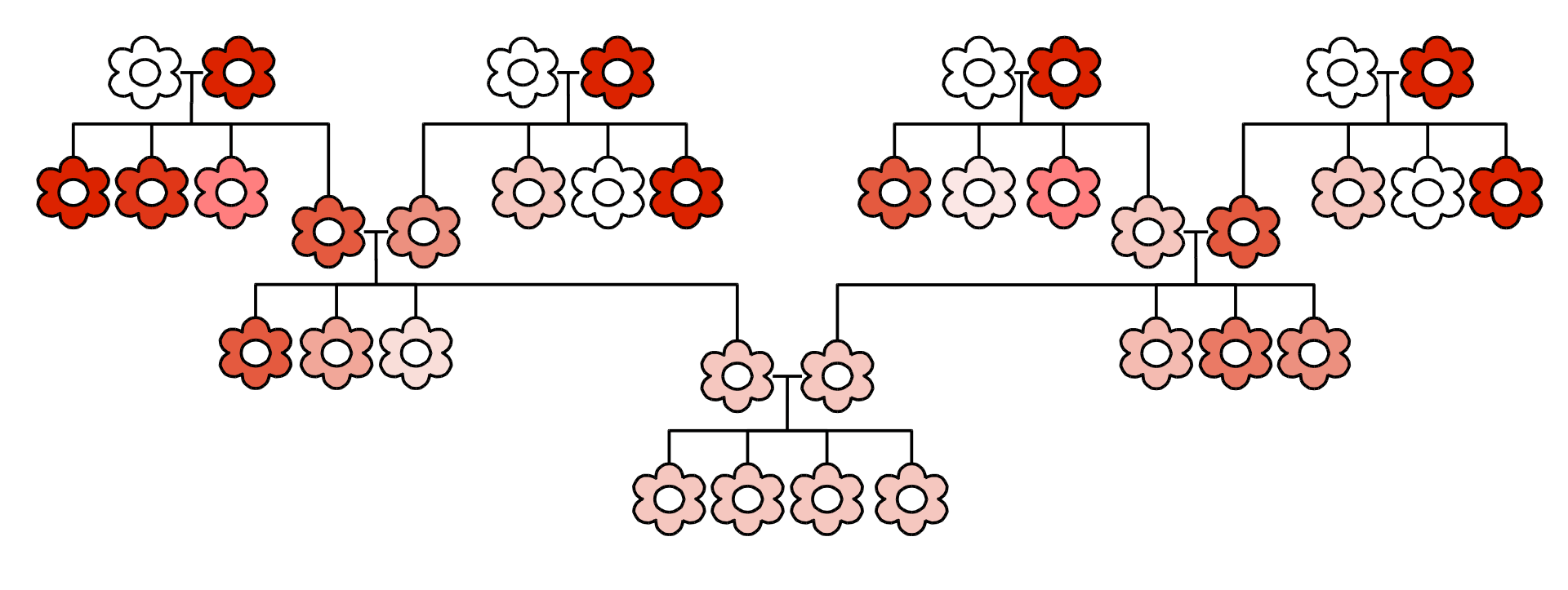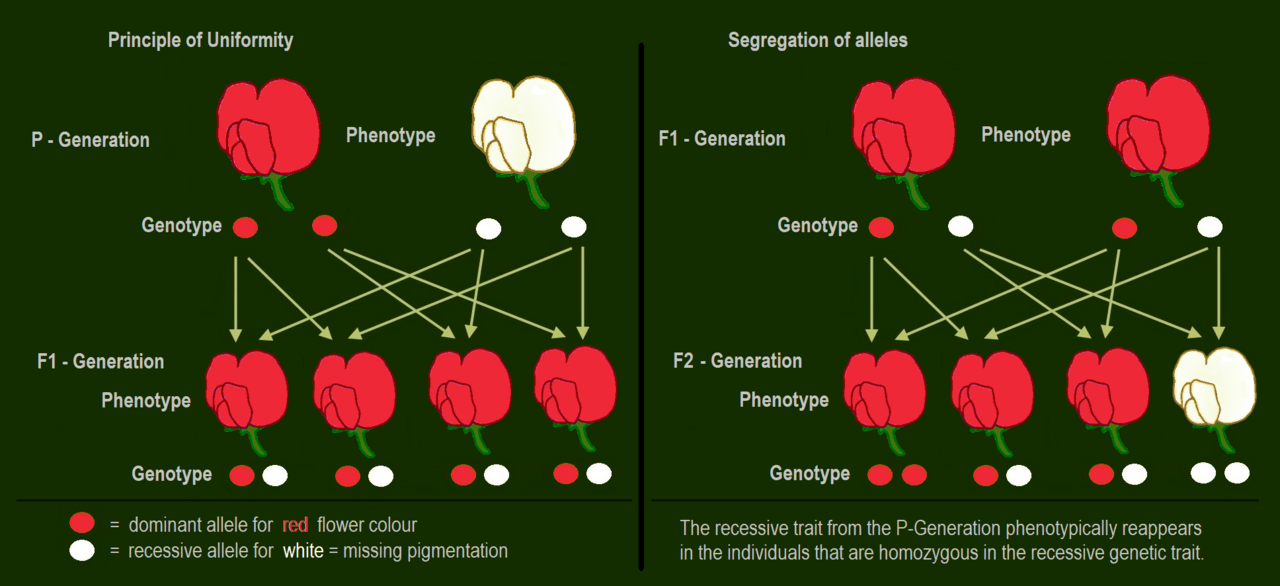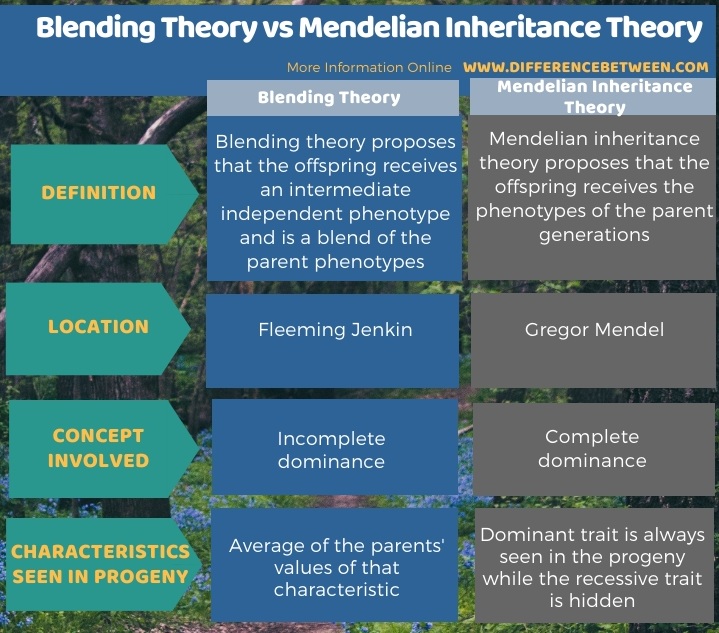Difference Between Blending Theory and Mendelian Inheritance Theory
The key difference between Blending theory and Mendelian inheritance theory is that blending theory proposes that blending of parent characters give rise to an independent and average characteristic in progeny, while Mendelian inheritance theory explains that there is complete dominance of traits received from the parents.
Genetics play an important role in the field of biology and evolutionary biology. It is the principle concept of explaining the inheritance of organisms. Genetics is primarily divided as Mendelian Genetics and Non-Mendelian Genetics. Modern genetics is a combination of both. Blending theory is a non-Mendelian inheritance theory which proposes the mixing or blending of parent characteristics within the progeny, giving an average of the parents’ values of that characteristic.
CONTENTS
1. Overview and Key Difference
2. What is Blending Theory
3. What is Mendelian Inheritance Theory
4. Similarities Between Blending Theory and Mendelian Inheritance Theory
5. Side by Side Comparison – Blending Theory vs Mendelian Inheritance Theory in Tabular Form
6. Summary
What is Blending Theory?
Blending theory is a pre-Mendelian concept. According to this theory, there is a blending effect of parent factors or values that gives rise to a new organism. This phenomenon includes incomplete dominance of inheritance pattern. Therefore, it is also called a non-Mendelian inheritance pattern. It confers the fact that the offspring are heterozygous and does not possess the characteristics of either parent. However, it shows that the offspring receives an intermediate or average character in comparison to the parent characters.

Individuals may receive the original parent traits after many successive generations. Therefore, blending truly means the blending of genes and not only phenotypes. Thus, individual alleles blend during the blending theory of inheritance. For example, blending of two flowers, one with a light colour and another with a dark colour, give rise to an intermediate coloured flower, irrespective of the colour of the two parent flowers.
What is Mendelian Inheritance Theory?
Mendelian Inheritance theory was formulated by Gregor Mendel. The concept of Mendel Genetics was based on the theory of dominance. After his observations based on pea plants, he proposed two laws called the law of segregation and the law of independent assortment. The law of segregation explains that factors segregate during fertilization. He further stated that factors separate during the formation of gametes in organisms. These factors, at present, refer to genes and the separated factors are alleles. The second law of Mendel explained the theory of independent assortment. This states that the inheritance of one factor is independent of the other, irrespective of the origin of the gene.

The series of monohybrid and dihybrid crosses that he performed confirmed these two theories. He developed ratios to coincide with the theories he proposed upon his experiments. This paved the introduction of modern genetics.
What are the Similarities Between Blending Theory and Mendelian Inheritance Theory?
- Both blending theory and Mendelian inheritance theory contribute to the inheritance patterns on organisms.
- They support the concept of evolutionary genetics.
- Both theories consider the behaviour of genetics in inheritance.
- Moreover, they consider the action of genes and alleles in inheritance.
What is the Difference Between Blending Theory and Mendelian Inheritance Theory?
The key difference between blending theory and Mendelian inheritance theory is that blending theory concerns the concept of incomplete dominance, while Mendelian inheritance theory concerns the concept of complete dominance. Furthermore, blending theory works as a non-Mendelian inheritance pattern since it states that progeny receives an average of the parents’ values of that characteristic, while mendelian inheritance theory states that dominant trait is always seen in the progeny while the recessive trait is hidden.
The below infographic summarizes the difference between blending theory and Mendelian inheritance theory.

Summary – Blending Theory vs Mendelian Inheritance Theory
Blending theory is the theory that focuses on blending the characteristics of the parents in the offspring. Thus, it focuses on the concept of incomplete dominance of inheritance. Mendelian inheritance theory, on the other hand, focuses on the complete dominance of characters in the process of inheritance. It describes two laws: the law of segregation and the law of independent assortment. So, this is the key difference between blending theory and Mendelian inheritance theory. However, both concepts widely contribute to the genetics of inheritance.
Reference:
1. “Gregor Mendel and the Principles of Inheritance.” Nature News, Nature Publishing Group, Available here.
2. “Blending Theory.” Scribd, Available here.
Image Courtesy:
1. “Blending inheritance” By Squididdily at en.wikipedia (CC BY-SA 3.0) via Commons Wikimedia
2. “Dominant-recessive inheritance – flowers of pea plants” By Sciencia58 – Own work (CC0) via Commons Wikimedia
ncG1vNJzZmivp6x7pbXFn5yrnZ6YsqOx07CcnqZemLyue8OinZ%2Bdopq7pLGMm5ytr5Wau26uy56lnaGenHq1tMSoqbJlkaOxbrnEp5uepJmWu261zaGcq6GklruksYytn56noq58